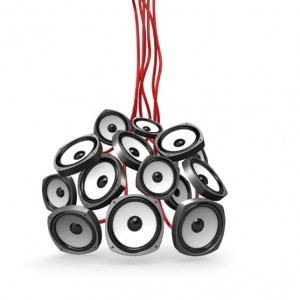Is More Speaker Really Better?

Pretty much the coolest thing you can do with audio is make a huge wall of speakers (or single huge speaker like Marty McFly in Back to the Future) by tying them all together and then, BLAST THE MUSIC! Well, at least that is what I thought years ago. Hey, it makes sense, right? Most people truly believe that the more speakers you have, the higher the chance you’ll get that euphoric immersive feeling of “surround sound.” However, in this post I will uncover three commonly overlooked points when plugging in all those speakers.
“Plug as many speakers you want in to the stereo. You’ll get bigger the sound.” This is a myth, though I admit it does look cool. If you have actually done this you probably noticed that the volume on the stereo or amplifier had to be turned up. This is because the ohm load or impedance dropped every time you added one.
First, a Simplified Definition: Impedance is the electrical characteristic of a speaker that restricts (impedes) the flow of power from your receiver or amplifier. Impedance is the combination of the resistance of a speaker plus its reactance. OK, that was techie; stay with me. Let’s use water flow as a more common example.
A useful analogy for the understanding of impedance is that of a water pipe and pump. The pipe diameter represents the impedance of your loudspeaker. The water flowing through it is power and the water pump is the amplifier (or receiver) itself. The pump pumps water through the pipe. A large diameter pipe allows a large amount of water to flow. This is a low impedance situation as the large pipe does not impede the large flow of water. A small diameter pipe allows less water to flow. This is a high impedance situation as the small pipe impedes the flow of water, keeping it small. Low impedance, large flow of power; high impedance, smaller flow of power. Increasing the pipe diameter (lowering the impedance) increases the water flow (current) but causes the water pump (amplifier) to work harder to maintain the desired amount of water pressure (voltage). In cases where a low quality amplifier attempts to “drive” (pump) its small amount of power into an impedance that is too low (too large a pipe), it may overheat and shut down. In extreme cases, the receiver can break. Some receivers and amps are built to put out “high current” flows and can drive virtually any real-world speaker load without breaking a sweat. But many, particularly in the lower-cost range, simply cannot. Trying to get more power out of an amp that’s not built for it is a sure way to wreak destruction.

Let’s stop here and regroup. What types of AV equipment can restrict current flow?
Answer: Speakers, Volume controls and the speaker wire.
Which one of these three is most commonly thought of as the least important?
Answer: The wire.
The fact is none of the time and money you spent on the speakers, placement of all the equipment, volume controls and amplifiers makes any difference if you have not done the math on the wire gauge needed. There are a wide variety of speaker wiring options on the market, ranging from the equivalent of standard lamp cord to exotic cables costing thousands of dollars per foot. In most applications, the effect that speaker cable will have on your audio system can be calculated from a few common characteristics.
I am feeling generous, so here are the answers in the back of the book i.e. world wide web. TIP: First Read “Learn more how to use the Cable Loss Calculator” at the top of the page.
Just plug in your Amplifier, Loudspeaker rating and speaker wire gauge you are thinking of using and this will generate recommended cable and length to use with your new audio system.
Further reading, and the resources for some of this information, can be found here. Thank you to Paul DiComo.
Still blasting music!

